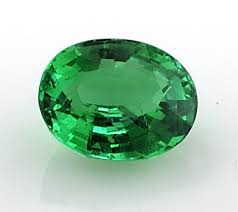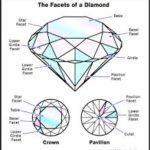Difference between Emerald and Green Beryl
Emerald and Green Beryl – both belong to the same species – Beryl. Yet, there are many differences between both. To clearly understand the differences it is firstly essential to have a brief introduction of these green-colored gemstones.

Introduction to Emerald
Emerald is the most fascinating member of the Beryl family. It is a green to a greenish-blue variety of Beryl. Mineral species Beryl consists of Aquamarine and other colors like red beryl, golden beryl, yellow beryl, orange beryl, pink Beryl also. Emeralds and Aquamarines are by far the most common and well-known varieties of Beryl.

Emeralds are formed with a combination of common elements aluminum and silicon with the rare element beryllium. The trace amounts of either chromium or vanadium or the combination of both give Emerald a distinctive green color. While the presence of iron gives the stone a slightly bluish tint.
View this post on Instagram
Emeralds are formed typically in six-sided prisms, which make them naturally suited to be shaped into the emerald cut. Emeralds are one of the most valuable gemstones available today. Most of the Emeralds are generally heavily included which makes their ability to resist the breakage very poor in comparison to Ruby and Sapphire. On Moh’s Scale of Hardness Emeralds are valued at 7.5 to 8 which makes them a bit prone to scratches.
The most common treatment given to Emerald is oiling. Oiling of Emeralds with cedar oil is done to cover the presence of fissures, flaws, and impurities. The use of cedar oil is now well-accepted practice in the gem trade but practices such as using green-tinted oil are not acceptable. Since the prices of Emeralds are very high Synthetic Emeralds have been discovered. They can be produced by two methods Flux growth and hydrothermal process. The difference between Synthetic and Natural Emerald can be found with the help of Chelsea Filter.
While reading this article if at all you feel like you want to contact us for any emerald stones we may have – get a bargain price and buy from us, simply visit the Zambia emerald page here. By the way, did you know about the post-Ethiopian emerald stones that came out in 2018? There is also a great piece of content written by Navneet Agarwal, the gemologist at NGM, please click here to read about the information on emeralds such as treatments, quality, color…
Introduction to Green Beryl

The pale green shade of Beryl is referred to as Green Beryl. Beryl is a cyclosilicate with the chemical composition Be3Al2 (SiO3)6. Green Beryl is colored by the presence of iron. Iron usually provides a yellow secondary color in Beryl and sometimes even a bluish secondary color. The variety of Beryl- Aquamarine is an example of the effect of iron. A Green Beryl gem can vary from translucent to transparent, which results in increasing the shine and brilliance of the gem.
This pale green gem can be found in South America, Afghanistan, Pakistan, South Africa, the Ural Mountains of Russia as well as in India. Green Beryl has been rated 7.5-8 on the Mohs Scale of Hardness. The excellent hardness, toughness, and resistance to corrosive substances make it very easy to use in many different jewelry applications.
The Green Beryl will most commonly feature vertically grooved and striated marking with vitreous luster to its coloring. Skilled gemstone cutters usually cut this type of gemstone into a square or rectangular cut which increases the transparent aspect of this six-sided crystal gemstone. The usual traditional cuts are also seen like pears, rounds, ovals, emeralds, cushions, and many more. The most uncommon feature of Green beryl is that they are not typically treated or enhanced in any way.
Difference between Emerald and Green Beryl
1. Color variations: The color of Emerald can be green to greenish-blue. While the color of Green Beryl is pale green or very light green. Despite their belonging to the same mineral species Beryl.
2. Inclusions: Naturally, occurring Emeralds are generally heavily included which makes them less resistant to breakage or stretch. In comparison, Green Beryls are very less included. Below are the pictures of Emerald and Green Beryl. Emerald has three-phase inclusions in it while Green Beryl has very few inclusions that are not visible by the naked eye. If you would like to find out a full clarity guide on emeralds then this quality chart is for you.
3. Different Trace Elements: Emeralds are green because of the presence of chromium or vanadium (or a combination of both). While, Green Beryl is green because of the presence of iron. Emeralds that have traces of iron will have a yellow tint in them but still have either or both chromium and vanadium.
4. Rarity: Emeralds are very rare to be found as compared to Green Beryl. As it is a rare event when Beryl is formed in a location where it is directly exposed to either chromium or vanadium (or a combination of both). This makes Emeralds so very rare. Even, Emeralds are 20times rarer than Diamonds.
5. Crystal Structure: The crystal structure of both of these gemstones are hexagonal in nature. Green Beryl is colored by traces of iron (very pale greenish-blue) is frequently heated to remove the green component and marketed as Aquamarine. Thus, Aquamarine is sold at much higher prices than Green Beryl.
6. Prices: The prices of Emerald and Greeb Berlys also vary. Emeralds come in many varieties, lower quality Emeralds are available 1$per carat-5$per carat whereas medium quality comes around 5,000$/ carat -9,000$/ carat. While the topmost quality of Emeralds can go beyond 10,000$per carat. In comparison to the Emeralds, the price of Green Beryls is very low. They are priced between 1$/carat-2$/carat.
7. Origin Sources: Emeralds are mined from the countries like Colombia, Brazil, Zambia, and Zimbabwe. While, Green Beryls are mined from the countries like Afghanistan, Pakistan, The Ural mountains of Russia, South Africa, South America, and many more.
8. Refractive Index: Refractive Index is measured using a refractometer, it is an indication of the number of light rays are bent by the mineral. The refractive index of Emerald is 1.565-1.602 whereas, Green Beryl has a refractive index of 1.58-1.59.
9. Association with Zodiac Sign: Emerald is associated with Zodiac sign Taurus whereas, Green Beryl is associated with Scorpio.
For the latest updates on the gemstones, Check out our Instagram Page Now!
Conclusion:
Emerald and Green Beryl gemstones are quite different from each other despite their belonging to the same mineral species- Beryl. Both of these gemstones come under the color green but shades are different. The presence or absence of chromium, vanadium, and iron makes a variation in the color of the Beryls. In a single rough crystal, it is possible that one end has got chromium concentration and another end does not have. The rarity of Emeralds resulted in the higher prices of these gems. The hardness of Green Beryl and Emerald is the same but still, Emeralds are more prone to breakage and stretches because of the high inclusions in them.
Emerald Gemological Properties:
|
Species |
Emerald- beryl |
| Chemical Formula | Al2Be3Si6018- Aluminum beryllium silicate |
| Crystal Structure | Hexagonal; hexagonal prisms |
| Color | Emerald green to green to slightly bluish or yellowish-green |
| Hardness | 7.5 to 8 on the Mohs Scale |
| Refractive Index | 1.565 to 1.602 |
| Density | 2.67 to 2.78 |
| Cleavage | Indistinct |
| Transparency | Transparent to opaque |
| Birefringence | -0.006 |
| Luster | Vitreous |
| Fluorescence | Usually no |


